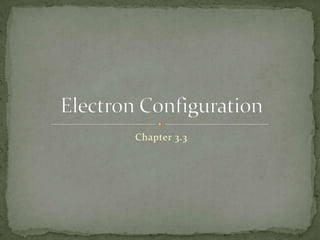
Applied Chapter 3.3 : Electron Configuration
- 1. Chapter 3.3 Electron Configuration
- 2. Objective 1: Compare the Rutherford, Bohr, and Quantum models of the atom. Rutherford’s model of atom Electrons orbit the nucleus just as planets orbit the sun Bohr’s model of the atom Electrons travel around the nucleus in specific energy level Quantum – difference in energy between two energy levels. Bohr Video
- 3. Quantum model of the atom Electrons are found in orbitals around the nucleus of atom. Orbital (electron cloud) – region of atom where there is a high probability of finding electrons
- 4. Electrons – Act like particles and waves Particles Cathode ray tube Photoelectric effect Waves Electromagnetic spectrum Line-emission spectrum
- 5. Objective 2: Explain how the wavelengths of light emitted by an atom provide information about energy levels. Light provides information about electrons Neon Electrons start in ground state Lowest possible energy level Run electricity through gas Electrons absorb this energy They move to excited state Electron has more energy than normal Quickly fall back to ground state Energy is emitted as light Light has a specific wavelength Determines color (and line-emission spectrum) Krypton Argon
- 7. Objective 3: List the four quantum numbers, and describe their significance. Quantum numbers: Number that specifies the properties of electrons Tells where they are in the atom. Principle quantum number ( n ) Main energy level n = 1,2,3,4,5 …….. Infinity Distance from nucleus Angular Momentum quantum number ( l ) indicates the shape of the orbital l = 0, 1, 2, 3 s p d f s p d
- 9. 4. Spin Quantum Number ( +1/2, -1/2) or , Indicates the two fundamental spin states of electron in an orbital Single orbital can hold a maximum of 2 electrons
- 11. Quantum Numbers of the 1st thirty atomic orbitals Total Electrons in n 2 8 18 32
- 12. Objective 4 Write the electron Configuration of an atom by using the Pauli Exclusion principle and the aufbau principle. Electron Configuration The arrangement of electrons in an atom Lowest-energy arrangement – ground-state electron configuration Rules Governing Electron Configuration Aufbau Principle – electron occupies the lowest-energy orbital that can receive it. Pg. 105 Pauli exclusion Principle – no two electrons in the same atom can have the same set of four quantum numbers Hund’s Rule – orbitals of equal energy are each occupied by one electron before any orbital is occupied by a second electron, and all electrons in singly occupied orbitals must have the same spin.
- 13. Aufbau principle 4f 5f 6f 7f 3d 4d 5d 6d 7d 2p 3p 4p 5p 6p 7p 1s 2s 3s 4s 5s 6s 7s ** Gives the order of energy levels and orbitals
- 15. Hund’s Rule